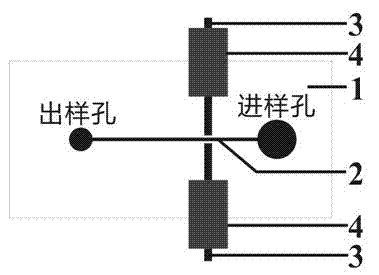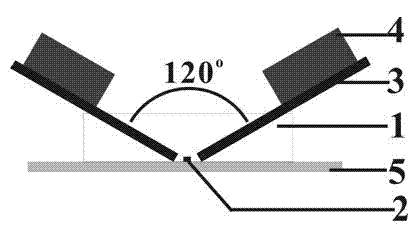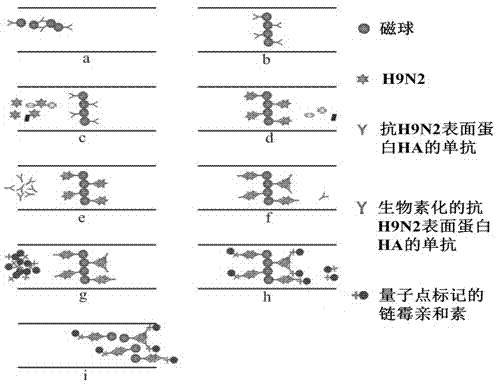Pathogen detection method based on micro-fluidic chip
A microfluidic chip, pathogen detection technology, applied in the fields of chemistry and biomedicine, can solve the problems of high cost, complex processing, time-consuming, etc., and achieve the effects of high specificity, strong maneuverability, and excellent optical properties
- Summary
- Abstract
- Description
- Claims
- Application Information
AI Technical Summary
Problems solved by technology
Method used
Image
Examples
Embodiment 1
[0026] (1) Manufacturing method of integrated chip
[0027] Using standard soft lithography production technology, a layer of AZ50XT photoresist is cast on the clean and flat surface of the silicon wafer to obtain a thickness of about 40 μm. Under the cover of the printed film mask, it is exposed and developed with ultraviolet rays to obtain A standard mask that protrudes from the surface of the silicon wafer. Fix two self-made magnetic rods on both sides of the male mold microchannel, the angle between the magnetic rods is 0-180 o , the angle between the plane formed by the magnetic bar and the plane of the microchip is 90 o , reconcile the prepolymer mass ratio of polydimethylsiloxane (PDMS) to 10:1 (mass ratio), vacuum out the air bubbles, pour it on the mask, and then bake it in an oven at 75°C for 3-4 hours, After curing, cut it with a scalpel, lift it from the mask, and copy the pattern to the PDMS, use a flat punched needle to punch the sample and sample outlet; clean...
Embodiment 2
[0036] An integrated chip was fabricated by using the method in Example 1, and magnetic balls modified with anti-H9N2 avian influenza virus surface protein HA monoclonal antibody and biotinylated anti-H9N2 avian influenza virus surface protein HA monoclonal antibody were prepared. Then a magnetic sandwich immunofluorescence reaction was performed on the chip to detect H9N2. Figure 4 Fluorescent images (a) and corresponding spectral images (b) of different concentrations of H9N2 magnetic fluorescence immunoassay. Figure 5 is the change trend diagram (a) of different concentrations of H9N2 and fluorescence intensity, and the standard curve diagram (b), and Figure 4 correspond. Figure 6 In order to detect the specificity analysis of the H9N2 magnetic sandwich immunofluorescence detection method, the fluorescence picture (a) and the corresponding spectrum picture (b). Figure 7 In order to detect the specificity analysis of H9N2 magnetic sandwich immunofluorescence detecti...
Embodiment 3
[0038] An integrated chip was fabricated by using the method in Example 1, and magnetic balls modified with anti-Newcastle disease virus (NDV) surface protein HA monoclonal antibody and biotinylated anti-Newcastle disease virus (NDV) surface protein HA monoclonal antibody were prepared. Then a magnetic sandwich immunofluorescence reaction was performed on the chip to detect H9N2. Figure 8 Fluorescence graphs, spectrograms, and standard curves of magnetic fluorescent immunoassays for different concentrations of NDV. Figure 9 In order to detect the specificity analysis of the NDV magnetic sandwich immunofluorescence detection method, it includes the fluorescence diagram, spectrum diagram and histogram of the reagent blank and negative control.
PUM
 Login to View More
Login to View More Abstract
Description
Claims
Application Information
 Login to View More
Login to View More - R&D
- Intellectual Property
- Life Sciences
- Materials
- Tech Scout
- Unparalleled Data Quality
- Higher Quality Content
- 60% Fewer Hallucinations
Browse by: Latest US Patents, China's latest patents, Technical Efficacy Thesaurus, Application Domain, Technology Topic, Popular Technical Reports.
© 2025 PatSnap. All rights reserved.Legal|Privacy policy|Modern Slavery Act Transparency Statement|Sitemap|About US| Contact US: help@patsnap.com



